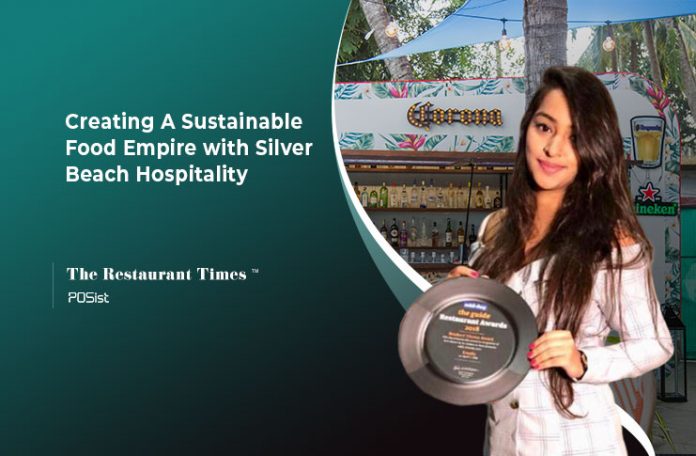F&B Entrepreneur Twinkle Keswani transitioned from being a banker to a successful restauranteur with great aplomb. Twinkle is the Executive Vice President of Silver Beach Entertainment & Hospitality which owns brands like Silver Beach Cafe, Nom Nom, Radio Bar, Estella, The Lazy Goose. Twinkle’s creativity and tenacity ultimately led her to the brilliance that is Toro Toro in Goa. It is an unconventional bar designed to look like a caravan and contains all the best spirits!
In Conversation With Twinkle Keswani of Silver Beach Entertainment & Hospitality
In an exclusive conversation with The Restaurant Times, Twinkle Keswani talks of her journey in the industry, restaurant expansion strategies, and a lot more.
Restaurant Expansion Strategies
As you plan to expand your restaurant, you need to assure that you safeguard your restaurant brand. Here are some of the strategies to be taken care of according to Keswani:
Demographics of the Selected Location: After selecting the location of your second outlet, it is important to examine the market of that particular location. The flow of traffic and eating patterns have to be analyzed in the location you’re considering, says Keswani. It is the duty of the restaurateur to find out the need of the hour in the specified location. If you are planning to open your second outlet close to the first one, it could be easier to manage two locations close to one another, but it might limit your customer pool.
Considering Price Points: It is important to understand the price barrier while pricing the menu. If you are offering similar items as the surrounding eateries, but charging too much, you run the chance of pricing people out of enjoying your food, no matter how good it may be. Nonetheless, if you price things too low, you may devise the idea that your food is of lower quality, even if it is far above the competitors’ offerings. Keswani shares an example by saying in terms of consumption and price sensitivity, Navi Mumbai is more sensitive than Bandra. Consumers in Navi Mumbai are likely to be more affected by the pricing of the menu than the consumers in Bandra.
Maintaining Profit Margin Across All Outlets
The profit margin of a restaurant business is a metric that should always be on a restaurateur’s radar. It’s important to note that one’s profit margin isn’t just something you should measure; it’s a metric that you should continuously improve. Keswani shares her experience for maintaining the profit margins across several outlets.
Controlling Costs: Better cost control starts by tracking the food expenses of your restaurant business, says Keswani. It begins with tracking and monitoring the food coming into your restaurant. Many restaurants order food in bulk shipments, but it can be difficult to use all of that food before it spoils. While purchasing, one should keep a record of what you ordered, the quantity ordered and the quoted price. At check-in, verify that this matches what is physically at the back door and on the vendor’s invoice.
Restaurant Sales Forecasting: Your sales forecast sets the standards for your restaurant business’ expenses, profits, and growth. Keswani states that it’s important to estimate the amount of traffic your restaurant business will receive monthly. According to Keswani’s analysis, December will surely be better than March in terms of sales on the basis of economic trends and market analysis. It helps the business to make informed decisions, insightfully schedule your staff, purchase your inventory, and manage profit expectations.
Regular Audits: Keswani says that it is important to conduct inventory audits of food items every 15 days to check the previous day’s counts. It becomes crucial to ensure that accurate counts are reflected in your back-of-house system to get an accurate understanding of your stock and it helps in identifying any wastage or theft. These regular audits help to go to the very root of any mistakes made and in understanding the reasons behind them. It not only helps to fix them but also in improving them.
Market Analysis
With evolving customer expectations in terms of dining experience and convenience, the restaurant industry is expanding. Restaurateurs are stepping up their service and marketing innovations to surpass guest expectations and win over competitors. According to Keswani, a cafe format is the most profitable among other formats and has been an evergreen option. A cafe is the most preferred restaurant format as it is a pocket-friendly option for a vast majority of the audience and offers value for money. Keswani mentions that unlike a fine-dine restaurant where the audience is limited, a cafe format caters to a bigger audience.
Market analysis provides valuable insights regarding market trends and evolving consumer lifestyles so that restaurants of all types can better address and adhere to consumer demand. Keswani while comparing Bombay and Goa, says that the market analysis for both the cities would be different. In Bombay, the crowd is consistent and the audience is familiar, after analyzing a market physically and finding out what is missing in that particular location, a restaurateur can make a decision regarding what he/she can possibly open. On the other hand, Goa being a tourist destination involving consumers from different parts of the world, the peak seasons work the best there.
While concluding, Keswani says that understanding consumer demands is the key. Consumers base their purchasing decisions on many determinants, such as speed and consistency, convenience and service, quality and flavor, and even corporate responsibility. With so many factors to balance, even the most trivial contribution to business performance cannot be overlooked. Owning a restaurant can be a successful and fulfilling venture. Knowing your consumer’s demands and preferences can boost your revenue and increase productivity.



















